Report: Cost of Production in the Manufacturing Industry in Australia
VerifiedAdded on 2020/03/04
|6
|1451
|91
Report
AI Summary
This report analyzes the cost of production in the Australian manufacturing sector, focusing on labor costs, production taxes, and the impact of technology. The report examines the perspectives of various stakeholders, including the government, investors, and businesses, highlighting the significance of these costs in determining product pricing and overall economic health. It delves into economic concepts such as production taxes and technology adoption, and their effects on the manufacturing sector. The report also offers recommendations for key players, including the government and investors, such as production tax reduction, subsidies, and the adoption of modern technology, to foster a more competitive and sustainable manufacturing environment. Furthermore, the report stresses the importance of utilizing local resources, including labor and raw materials, to reduce costs and improve the sector's performance. The conclusion underscores the need for governmental support and internal resource utilization to enhance the manufacturing sector's competitiveness.

COST OF PRODUCTION IN MANUFACTURING INDUSTRY IN AUSTRALIA 1
Cost of production in manufacturing industry in Australia
Name of student
Name of institution
Name of instructor
Date
Cost of production in manufacturing industry in Australia
Name of student
Name of institution
Name of instructor
Date
Paraphrase This Document
Need a fresh take? Get an instant paraphrase of this document with our AI Paraphraser
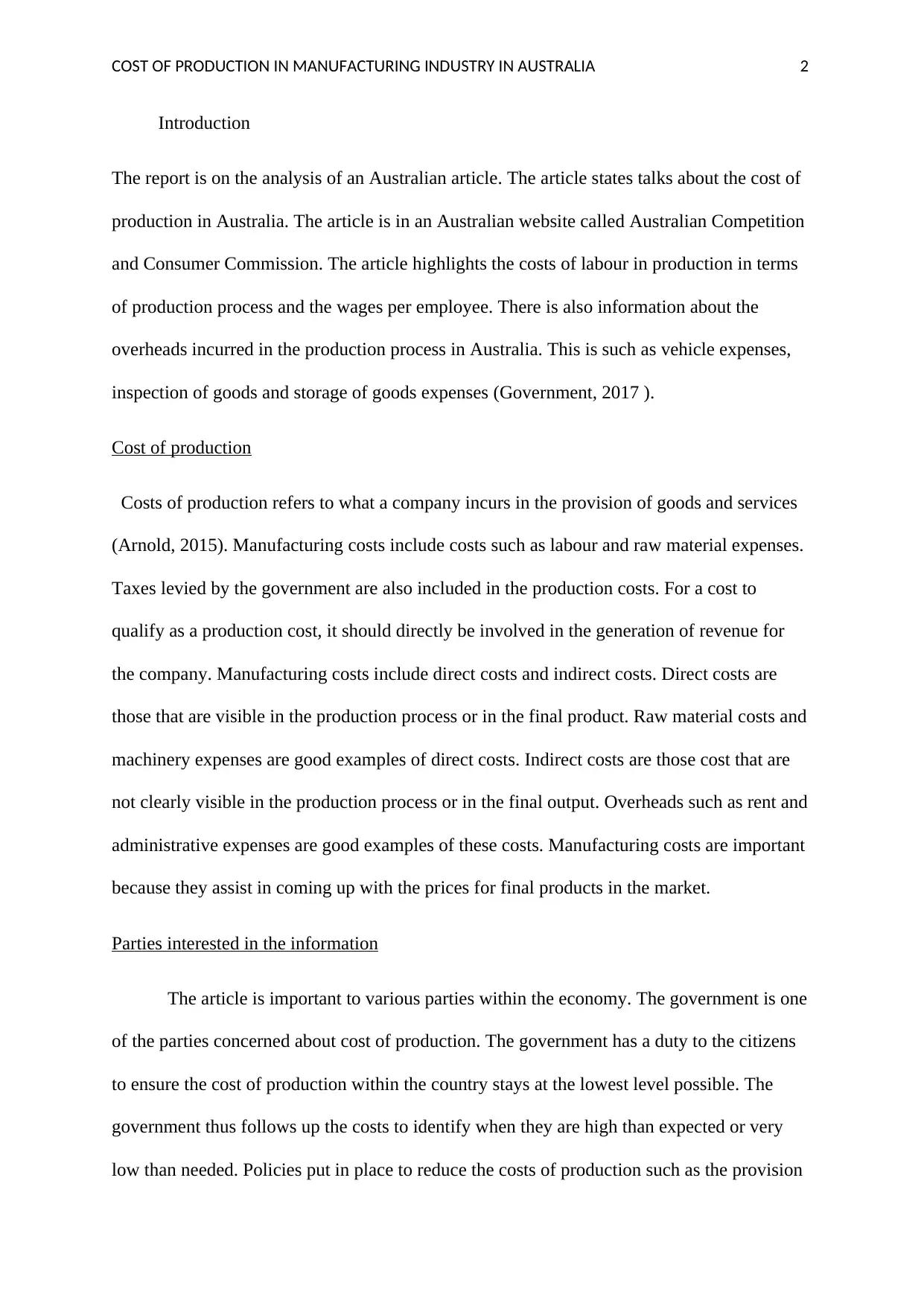
COST OF PRODUCTION IN MANUFACTURING INDUSTRY IN AUSTRALIA 2
Introduction
The report is on the analysis of an Australian article. The article states talks about the cost of
production in Australia. The article is in an Australian website called Australian Competition
and Consumer Commission. The article highlights the costs of labour in production in terms
of production process and the wages per employee. There is also information about the
overheads incurred in the production process in Australia. This is such as vehicle expenses,
inspection of goods and storage of goods expenses (Government, 2017 ).
Cost of production
Costs of production refers to what a company incurs in the provision of goods and services
(Arnold, 2015). Manufacturing costs include costs such as labour and raw material expenses.
Taxes levied by the government are also included in the production costs. For a cost to
qualify as a production cost, it should directly be involved in the generation of revenue for
the company. Manufacturing costs include direct costs and indirect costs. Direct costs are
those that are visible in the production process or in the final product. Raw material costs and
machinery expenses are good examples of direct costs. Indirect costs are those cost that are
not clearly visible in the production process or in the final output. Overheads such as rent and
administrative expenses are good examples of these costs. Manufacturing costs are important
because they assist in coming up with the prices for final products in the market.
Parties interested in the information
The article is important to various parties within the economy. The government is one
of the parties concerned about cost of production. The government has a duty to the citizens
to ensure the cost of production within the country stays at the lowest level possible. The
government thus follows up the costs to identify when they are high than expected or very
low than needed. Policies put in place to reduce the costs of production such as the provision
Introduction
The report is on the analysis of an Australian article. The article states talks about the cost of
production in Australia. The article is in an Australian website called Australian Competition
and Consumer Commission. The article highlights the costs of labour in production in terms
of production process and the wages per employee. There is also information about the
overheads incurred in the production process in Australia. This is such as vehicle expenses,
inspection of goods and storage of goods expenses (Government, 2017 ).
Cost of production
Costs of production refers to what a company incurs in the provision of goods and services
(Arnold, 2015). Manufacturing costs include costs such as labour and raw material expenses.
Taxes levied by the government are also included in the production costs. For a cost to
qualify as a production cost, it should directly be involved in the generation of revenue for
the company. Manufacturing costs include direct costs and indirect costs. Direct costs are
those that are visible in the production process or in the final product. Raw material costs and
machinery expenses are good examples of direct costs. Indirect costs are those cost that are
not clearly visible in the production process or in the final output. Overheads such as rent and
administrative expenses are good examples of these costs. Manufacturing costs are important
because they assist in coming up with the prices for final products in the market.
Parties interested in the information
The article is important to various parties within the economy. The government is one
of the parties concerned about cost of production. The government has a duty to the citizens
to ensure the cost of production within the country stays at the lowest level possible. The
government thus follows up the costs to identify when they are high than expected or very
low than needed. Policies put in place to reduce the costs of production such as the provision
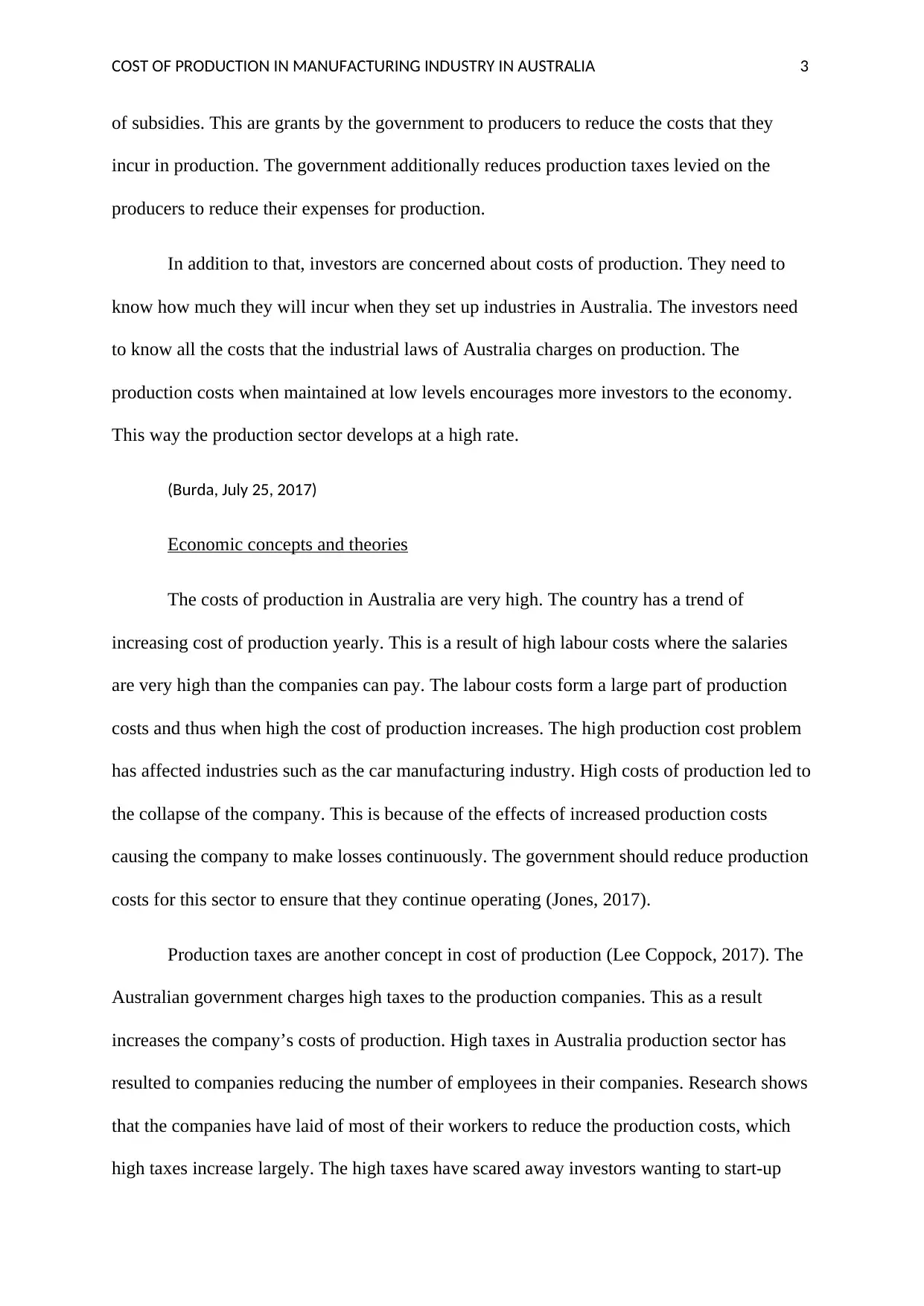
COST OF PRODUCTION IN MANUFACTURING INDUSTRY IN AUSTRALIA 3
of subsidies. This are grants by the government to producers to reduce the costs that they
incur in production. The government additionally reduces production taxes levied on the
producers to reduce their expenses for production.
In addition to that, investors are concerned about costs of production. They need to
know how much they will incur when they set up industries in Australia. The investors need
to know all the costs that the industrial laws of Australia charges on production. The
production costs when maintained at low levels encourages more investors to the economy.
This way the production sector develops at a high rate.
(Burda, July 25, 2017)
Economic concepts and theories
The costs of production in Australia are very high. The country has a trend of
increasing cost of production yearly. This is a result of high labour costs where the salaries
are very high than the companies can pay. The labour costs form a large part of production
costs and thus when high the cost of production increases. The high production cost problem
has affected industries such as the car manufacturing industry. High costs of production led to
the collapse of the company. This is because of the effects of increased production costs
causing the company to make losses continuously. The government should reduce production
costs for this sector to ensure that they continue operating (Jones, 2017).
Production taxes are another concept in cost of production (Lee Coppock, 2017). The
Australian government charges high taxes to the production companies. This as a result
increases the company’s costs of production. High taxes in Australia production sector has
resulted to companies reducing the number of employees in their companies. Research shows
that the companies have laid of most of their workers to reduce the production costs, which
high taxes increase largely. The high taxes have scared away investors wanting to start-up
of subsidies. This are grants by the government to producers to reduce the costs that they
incur in production. The government additionally reduces production taxes levied on the
producers to reduce their expenses for production.
In addition to that, investors are concerned about costs of production. They need to
know how much they will incur when they set up industries in Australia. The investors need
to know all the costs that the industrial laws of Australia charges on production. The
production costs when maintained at low levels encourages more investors to the economy.
This way the production sector develops at a high rate.
(Burda, July 25, 2017)
Economic concepts and theories
The costs of production in Australia are very high. The country has a trend of
increasing cost of production yearly. This is a result of high labour costs where the salaries
are very high than the companies can pay. The labour costs form a large part of production
costs and thus when high the cost of production increases. The high production cost problem
has affected industries such as the car manufacturing industry. High costs of production led to
the collapse of the company. This is because of the effects of increased production costs
causing the company to make losses continuously. The government should reduce production
costs for this sector to ensure that they continue operating (Jones, 2017).
Production taxes are another concept in cost of production (Lee Coppock, 2017). The
Australian government charges high taxes to the production companies. This as a result
increases the company’s costs of production. High taxes in Australia production sector has
resulted to companies reducing the number of employees in their companies. Research shows
that the companies have laid of most of their workers to reduce the production costs, which
high taxes increase largely. The high taxes have scared away investors wanting to start-up
⊘ This is a preview!⊘
Do you want full access?
Subscribe today to unlock all pages.

Trusted by 1+ million students worldwide
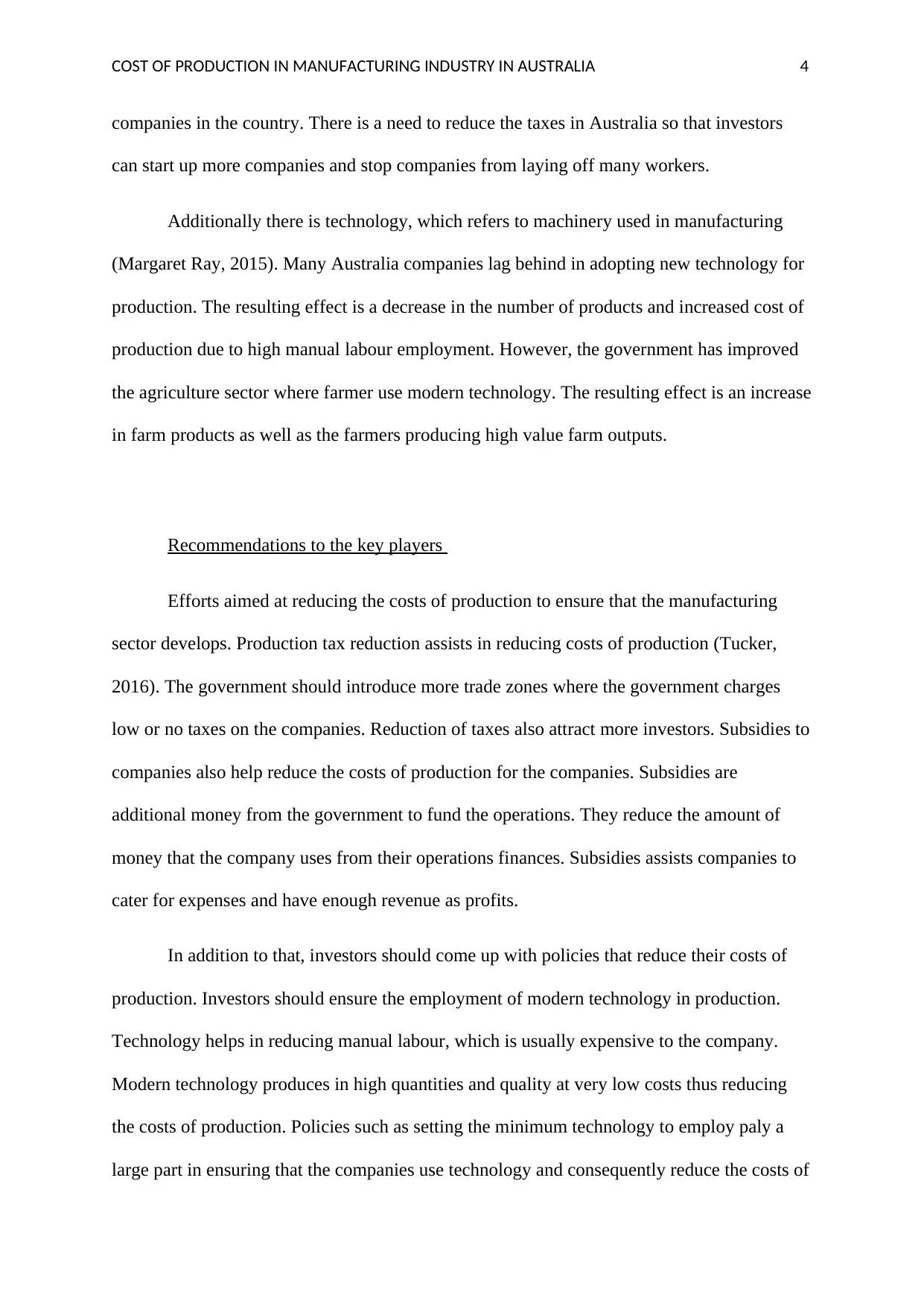
COST OF PRODUCTION IN MANUFACTURING INDUSTRY IN AUSTRALIA 4
companies in the country. There is a need to reduce the taxes in Australia so that investors
can start up more companies and stop companies from laying off many workers.
Additionally there is technology, which refers to machinery used in manufacturing
(Margaret Ray, 2015). Many Australia companies lag behind in adopting new technology for
production. The resulting effect is a decrease in the number of products and increased cost of
production due to high manual labour employment. However, the government has improved
the agriculture sector where farmer use modern technology. The resulting effect is an increase
in farm products as well as the farmers producing high value farm outputs.
Recommendations to the key players
Efforts aimed at reducing the costs of production to ensure that the manufacturing
sector develops. Production tax reduction assists in reducing costs of production (Tucker,
2016). The government should introduce more trade zones where the government charges
low or no taxes on the companies. Reduction of taxes also attract more investors. Subsidies to
companies also help reduce the costs of production for the companies. Subsidies are
additional money from the government to fund the operations. They reduce the amount of
money that the company uses from their operations finances. Subsidies assists companies to
cater for expenses and have enough revenue as profits.
In addition to that, investors should come up with policies that reduce their costs of
production. Investors should ensure the employment of modern technology in production.
Technology helps in reducing manual labour, which is usually expensive to the company.
Modern technology produces in high quantities and quality at very low costs thus reducing
the costs of production. Policies such as setting the minimum technology to employ paly a
large part in ensuring that the companies use technology and consequently reduce the costs of
companies in the country. There is a need to reduce the taxes in Australia so that investors
can start up more companies and stop companies from laying off many workers.
Additionally there is technology, which refers to machinery used in manufacturing
(Margaret Ray, 2015). Many Australia companies lag behind in adopting new technology for
production. The resulting effect is a decrease in the number of products and increased cost of
production due to high manual labour employment. However, the government has improved
the agriculture sector where farmer use modern technology. The resulting effect is an increase
in farm products as well as the farmers producing high value farm outputs.
Recommendations to the key players
Efforts aimed at reducing the costs of production to ensure that the manufacturing
sector develops. Production tax reduction assists in reducing costs of production (Tucker,
2016). The government should introduce more trade zones where the government charges
low or no taxes on the companies. Reduction of taxes also attract more investors. Subsidies to
companies also help reduce the costs of production for the companies. Subsidies are
additional money from the government to fund the operations. They reduce the amount of
money that the company uses from their operations finances. Subsidies assists companies to
cater for expenses and have enough revenue as profits.
In addition to that, investors should come up with policies that reduce their costs of
production. Investors should ensure the employment of modern technology in production.
Technology helps in reducing manual labour, which is usually expensive to the company.
Modern technology produces in high quantities and quality at very low costs thus reducing
the costs of production. Policies such as setting the minimum technology to employ paly a
large part in ensuring that the companies use technology and consequently reduce the costs of
Paraphrase This Document
Need a fresh take? Get an instant paraphrase of this document with our AI Paraphraser
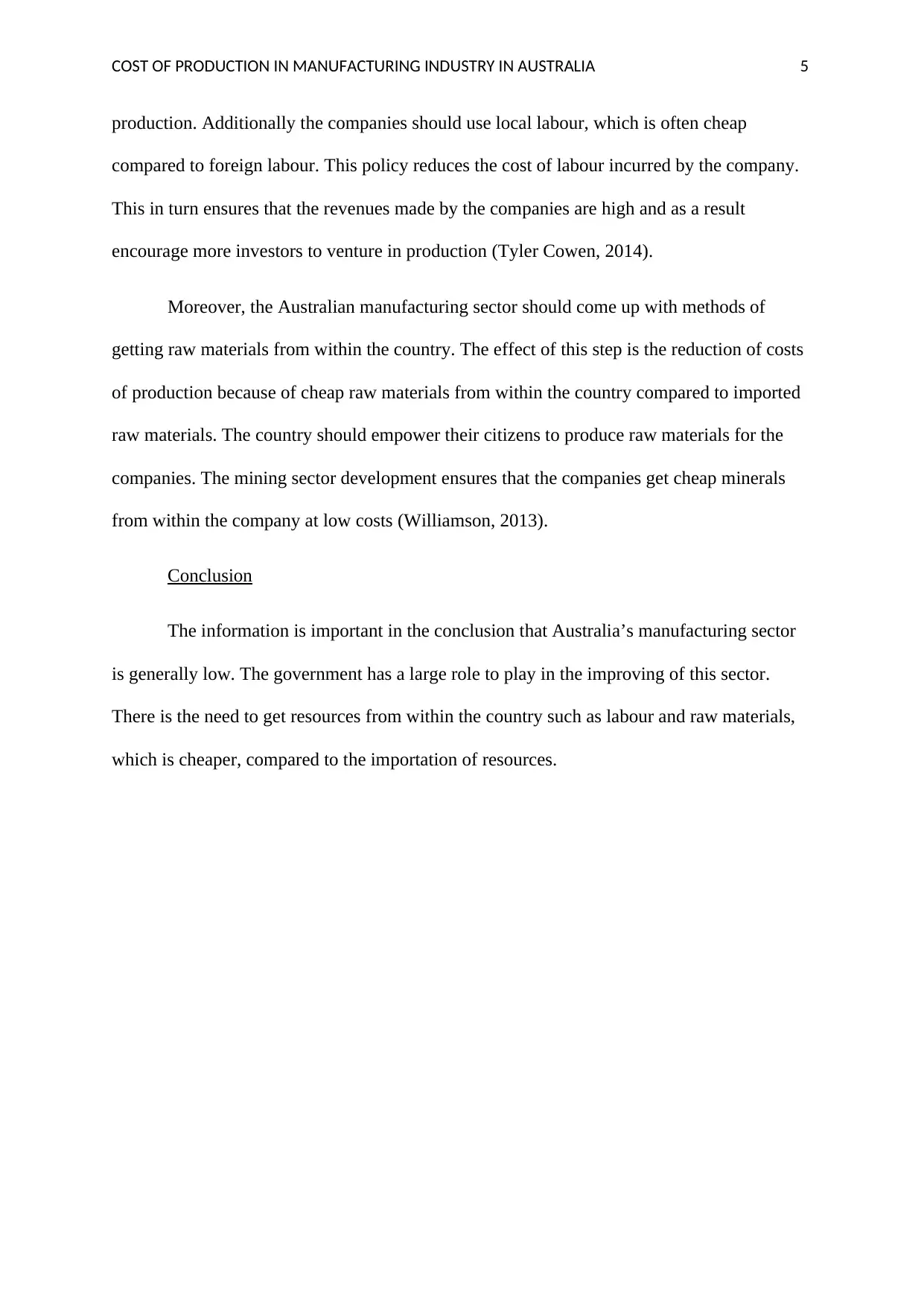
COST OF PRODUCTION IN MANUFACTURING INDUSTRY IN AUSTRALIA 5
production. Additionally the companies should use local labour, which is often cheap
compared to foreign labour. This policy reduces the cost of labour incurred by the company.
This in turn ensures that the revenues made by the companies are high and as a result
encourage more investors to venture in production (Tyler Cowen, 2014).
Moreover, the Australian manufacturing sector should come up with methods of
getting raw materials from within the country. The effect of this step is the reduction of costs
of production because of cheap raw materials from within the country compared to imported
raw materials. The country should empower their citizens to produce raw materials for the
companies. The mining sector development ensures that the companies get cheap minerals
from within the company at low costs (Williamson, 2013).
Conclusion
The information is important in the conclusion that Australia’s manufacturing sector
is generally low. The government has a large role to play in the improving of this sector.
There is the need to get resources from within the country such as labour and raw materials,
which is cheaper, compared to the importation of resources.
production. Additionally the companies should use local labour, which is often cheap
compared to foreign labour. This policy reduces the cost of labour incurred by the company.
This in turn ensures that the revenues made by the companies are high and as a result
encourage more investors to venture in production (Tyler Cowen, 2014).
Moreover, the Australian manufacturing sector should come up with methods of
getting raw materials from within the country. The effect of this step is the reduction of costs
of production because of cheap raw materials from within the country compared to imported
raw materials. The country should empower their citizens to produce raw materials for the
companies. The mining sector development ensures that the companies get cheap minerals
from within the company at low costs (Williamson, 2013).
Conclusion
The information is important in the conclusion that Australia’s manufacturing sector
is generally low. The government has a large role to play in the improving of this sector.
There is the need to get resources from within the country such as labour and raw materials,
which is cheaper, compared to the importation of resources.
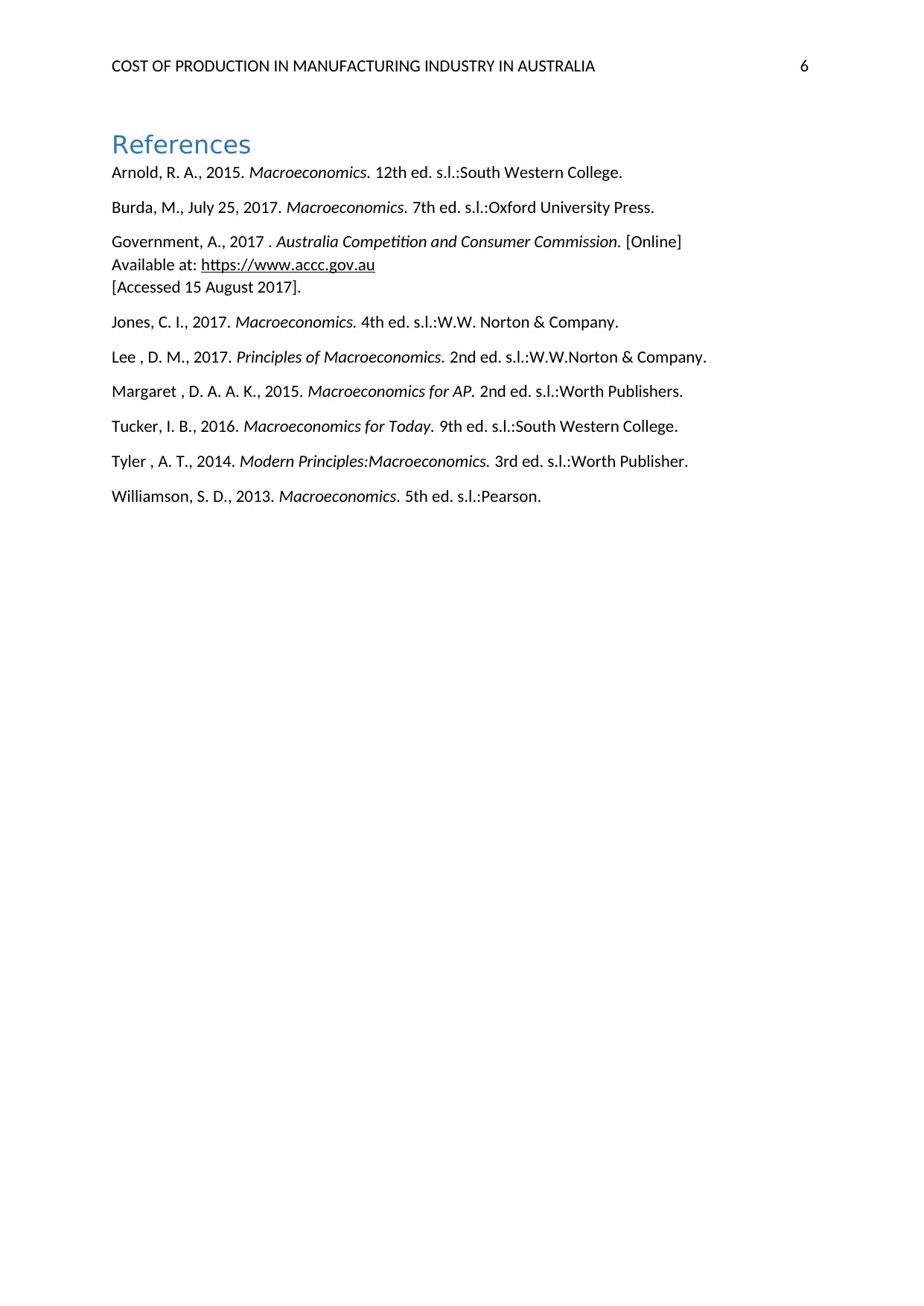
COST OF PRODUCTION IN MANUFACTURING INDUSTRY IN AUSTRALIA 6
References
Arnold, R. A., 2015. Macroeconomics. 12th ed. s.l.:South Western College.
Burda, M., July 25, 2017. Macroeconomics. 7th ed. s.l.:Oxford University Press.
Government, A., 2017 . Australia Competition and Consumer Commission. [Online]
Available at: https://www.accc.gov.au
[Accessed 15 August 2017].
Jones, C. I., 2017. Macroeconomics. 4th ed. s.l.:W.W. Norton & Company.
Lee , D. M., 2017. Principles of Macroeconomics. 2nd ed. s.l.:W.W.Norton & Company.
Margaret , D. A. A. K., 2015. Macroeconomics for AP. 2nd ed. s.l.:Worth Publishers.
Tucker, I. B., 2016. Macroeconomics for Today. 9th ed. s.l.:South Western College.
Tyler , A. T., 2014. Modern Principles:Macroeconomics. 3rd ed. s.l.:Worth Publisher.
Williamson, S. D., 2013. Macroeconomics. 5th ed. s.l.:Pearson.
References
Arnold, R. A., 2015. Macroeconomics. 12th ed. s.l.:South Western College.
Burda, M., July 25, 2017. Macroeconomics. 7th ed. s.l.:Oxford University Press.
Government, A., 2017 . Australia Competition and Consumer Commission. [Online]
Available at: https://www.accc.gov.au
[Accessed 15 August 2017].
Jones, C. I., 2017. Macroeconomics. 4th ed. s.l.:W.W. Norton & Company.
Lee , D. M., 2017. Principles of Macroeconomics. 2nd ed. s.l.:W.W.Norton & Company.
Margaret , D. A. A. K., 2015. Macroeconomics for AP. 2nd ed. s.l.:Worth Publishers.
Tucker, I. B., 2016. Macroeconomics for Today. 9th ed. s.l.:South Western College.
Tyler , A. T., 2014. Modern Principles:Macroeconomics. 3rd ed. s.l.:Worth Publisher.
Williamson, S. D., 2013. Macroeconomics. 5th ed. s.l.:Pearson.
⊘ This is a preview!⊘
Do you want full access?
Subscribe today to unlock all pages.

Trusted by 1+ million students worldwide
1 out of 6
Related Documents
Your All-in-One AI-Powered Toolkit for Academic Success.
+13062052269
info@desklib.com
Available 24*7 on WhatsApp / Email
![[object Object]](/_next/static/media/star-bottom.7253800d.svg)
Unlock your academic potential
Copyright © 2020–2025 A2Z Services. All Rights Reserved. Developed and managed by ZUCOL.



